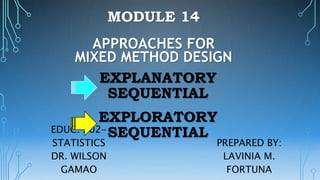Module 14 Approaches for Mixed Methos.pptx
•Download as PPTX, PDF•
0 likes•10 views
Statistics Topic
Report
Share
Report
Share

Recommended
More Related Content
Similar to Module 14 Approaches for Mixed Methos.pptx
Similar to Module 14 Approaches for Mixed Methos.pptx (20)
Ucc504 business research methods action research 230413

Ucc504 business research methods action research 230413
Observation and Research: Session 1 (Blended TEFL course)

Observation and Research: Session 1 (Blended TEFL course)
Recently uploaded
https://app.box.com/s/tkvuef7ygq0mecwlj72eucr4g9d3ljcs50 ĐỀ LUYỆN THI IOE LỚP 9 - NĂM HỌC 2022-2023 (CÓ LINK HÌNH, FILE AUDIO VÀ ĐÁ...

50 ĐỀ LUYỆN THI IOE LỚP 9 - NĂM HỌC 2022-2023 (CÓ LINK HÌNH, FILE AUDIO VÀ ĐÁ...Nguyen Thanh Tu Collection
The Author of this document is
Dr. Abdulfatah A. SalemOperations Management - Book1.p - Dr. Abdulfatah A. Salem

Operations Management - Book1.p - Dr. Abdulfatah A. SalemArab Academy for Science, Technology and Maritime Transport
Recently uploaded (20)
slides CapTechTalks Webinar May 2024 Alexander Perry.pptx

slides CapTechTalks Webinar May 2024 Alexander Perry.pptx
50 ĐỀ LUYỆN THI IOE LỚP 9 - NĂM HỌC 2022-2023 (CÓ LINK HÌNH, FILE AUDIO VÀ ĐÁ...

50 ĐỀ LUYỆN THI IOE LỚP 9 - NĂM HỌC 2022-2023 (CÓ LINK HÌNH, FILE AUDIO VÀ ĐÁ...
Incoming and Outgoing Shipments in 2 STEPS Using Odoo 17

Incoming and Outgoing Shipments in 2 STEPS Using Odoo 17
Keeping Your Information Safe with Centralized Security Services

Keeping Your Information Safe with Centralized Security Services
Salient features of Environment protection Act 1986.pptx

Salient features of Environment protection Act 1986.pptx
Operations Management - Book1.p - Dr. Abdulfatah A. Salem

Operations Management - Book1.p - Dr. Abdulfatah A. Salem
UNIT – IV_PCI Complaints: Complaints and evaluation of complaints, Handling o...

UNIT – IV_PCI Complaints: Complaints and evaluation of complaints, Handling o...
Removal Strategy _ FEFO _ Working with Perishable Products in Odoo 17

Removal Strategy _ FEFO _ Working with Perishable Products in Odoo 17
Post Exam Fun(da) Intra UEM General Quiz 2024 - Prelims q&a.pdf

Post Exam Fun(da) Intra UEM General Quiz 2024 - Prelims q&a.pdf
Module 14 Approaches for Mixed Methos.pptx
- 1. PREPARED BY: LAVINIA M. FORTUNA MODULE 14 APPROACHES FOR MIXED METHOD DESIGN EDUC. 202- STATISTICS DR. WILSON GAMAO EXPLANATORY SEQUENTIAL EXPLORATORY SEQUENTIAL
- 2. The most popular form of mixed methods approaches in educational research. Also referred to as a “two-phase model” • Intent: to explain quantitative results with qualitative data • Priority: quantitative data collection and analysis • Quantitative data is collected first • Qualitative data is used to refine results
- 3. Example of study: A mixed methods sequential explanatory study of the impact of chronic pain on family resistance (West, 2012) First, quantitative information was gathered: a survey of family members Second, qualitative information gathered to support qualitative: interviews (Creswell, 2015)
- 4. THE EXPLANATORY SEQUENTIAL DESIGN QUANTITATIVE Data Collection and Analysis Follow- up with QUALITATIVE Data Collection and Analysis Interpretation e.g. the researcher collects qualitative stories about adolescents’ attempts to quit smoking and analyzes the stories to identify the conditions, contexts, strategies, and consequences of adolescent quit attempts. Considering the resulting categories as variables, the researcher develops a quantitative instrument and uses it to assess the overall prevalence of these variables for a large number of adolescent smokers.
- 5. THE EXPLANATORY SEQUENTIAL DESIGN Philosophical assumptions: • Begin from constructivism for the qualitative phase • Shift to postpositivism for the quantitative phase Common variants: • Theory-development: development of an emergent theory/taxonomy/classification system, testing of the findings/theory with a larger sample • Instrument-development: gathering information to build a quantitative instrument
- 6. THE EXPLANATORY SEQUENTIAL DESIGN Philosophical assumptions: • Begin from constructivism for the qualitative phase • Shift to postpositivism for the quantitative phase Common variants: • Theory-development: development of an emergent theory/taxonomy/classification system, testing of the findings/theory with a larger sample • Instrument-development: gathering information to build a quantitative instrument
- 7. Opposite approach to the explanatory sequential design. Used often to explore a phenomenon, identify themes, and/or design an instrument & test it • Intent: use qualitative data to determine variables and questions that inform quantitative data collection • Priority: qualitative data emphasized over quantitative • Two phases: first to gather qualitative data from a small group, then follow up with quantitative data collection from a large group • Allows researcher to explore a problem before identifying variables, but is very time-consuming QUALITATIVE Data Collection and Analysis Build to QUANTITATIVE Data Collection and Analysis Interpretation (Creswell, 2015)
- 8. THE RESEARCHER THE EXPLORATORY SEQUENTIAL DESIGN Collects and analyzes qualitative data first followed by quantitative data Analyzes the qualitative data and uses results to build the subsequent quantitative phase Connects the phases by using the qualitative results to shape the quantitative phase by specifying research questions and variables, developing an instrument, and generating a typology
- 9. •Explore the field, because variables/theories/ hypotheses are unknown •Develop an instrument or typology that is not available •Assess whether qualitative themes generalize to a population PURPOSES FOR THE EXPLORATORY DESIGN
- 10. Choose this design if: • Researcher and research problem are qualitative oriented • Important variables not known and instruments not available • Have time to conduct two phases • Have limited resources and need to collect and analyze one data type at a time • New questions have emerged from qualitative results